John William Griffith, 1819 - 1901
by Brian Stevenson
last updated July, 2022
J.W. Griffith was an expert microscopist, using the instrument in his practice as a medical doctor and as an amateur botanist. He published numerous papers and books on microscopical observations and techniques throughout his life. The most famous of works is The Micrographic Dictionary, first published in 1856, a comprehensive tome that describes an extensive selection of specimens for microscopical examination (Figures 1 and 2).
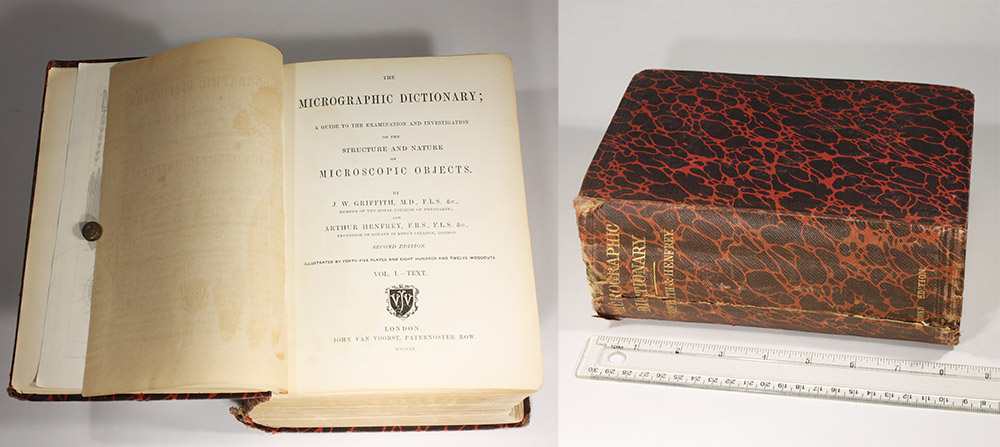
Figure 1.
The second edition of "The Micrographic Dictionary", 1860. It was first published in 1856, and co-authored with Arthur Henfrey (1819-1859). It was initially published as two volumes, with separate volumes for text and illustrations. The second edition, shown here, combined both volumes into a single tome that measures 8 inches // 20 cm tall and 3.5 inches // 8.5 cm thick.
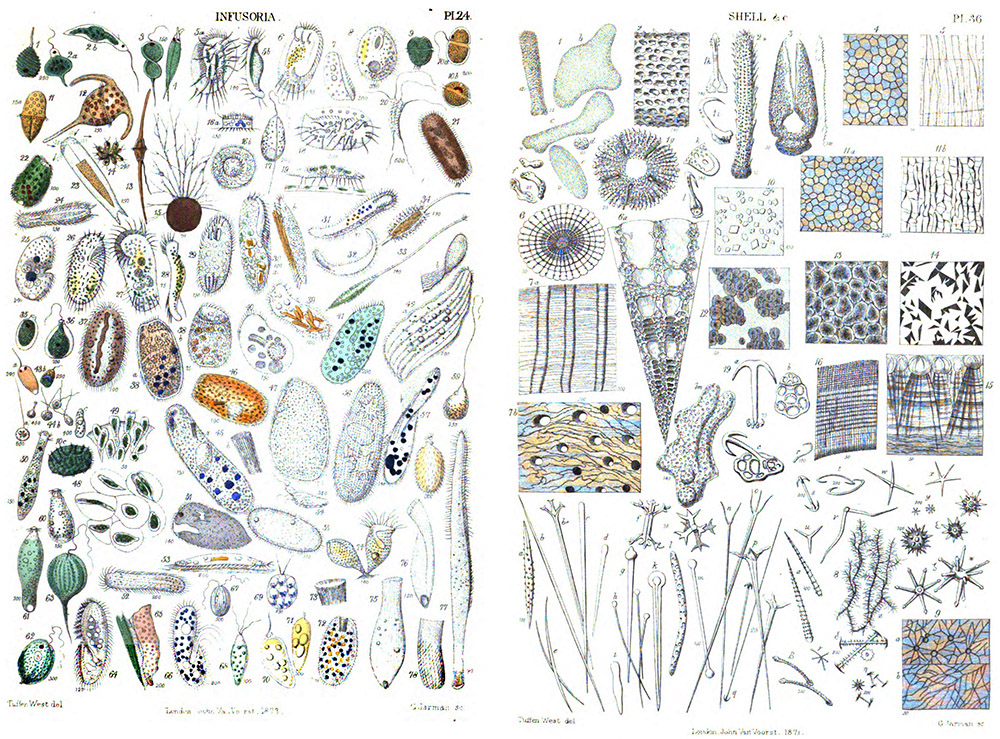
Figure 2.
Two plates of illustrations from "The Micrographic Dictionary". The drawings were prepared by the pre-eminent microscopical illustrator Tuffen West (1823-1891).
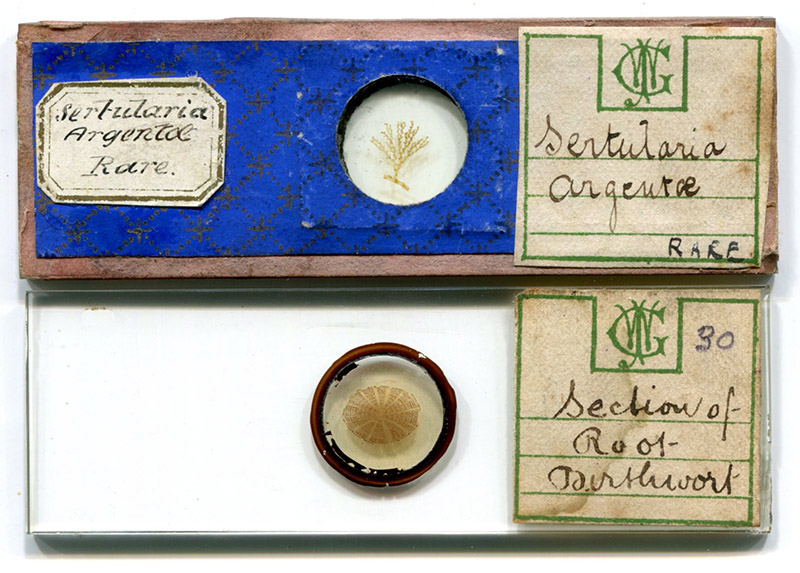
Figure 3.
Two ca. 1860-1880 microscope slides, each with a label bearing the monogram "J.W.G.". The monogram and evident age of the slides suggest that they were probably made by / owned by John W. Griffith.
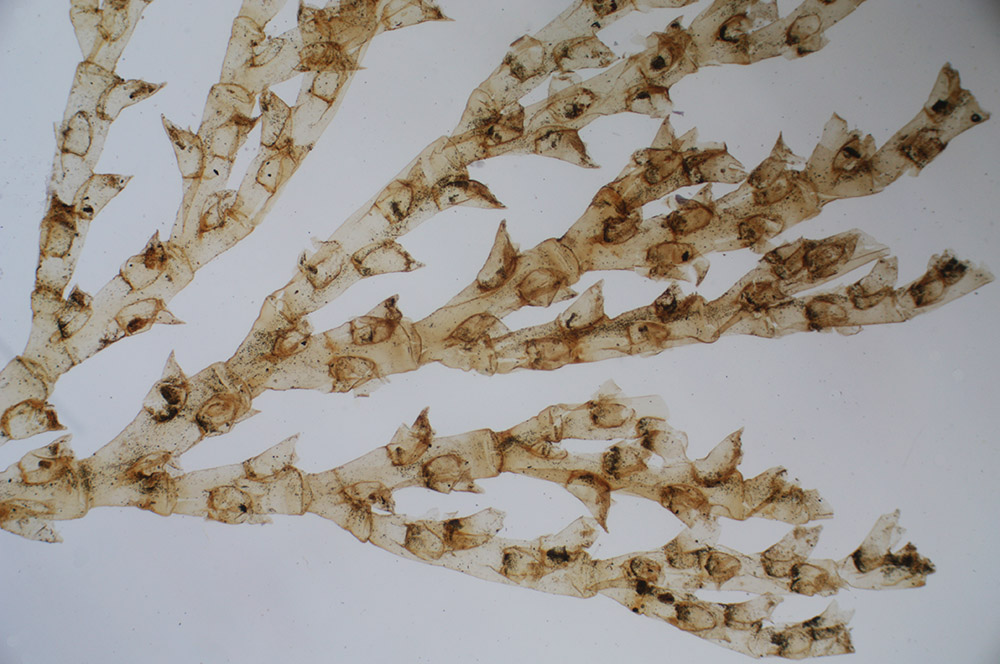
Figure 4.
Microscopical detail of Sertularia argentae, a hydroid commonly known as air fern or sea fern (see Figure 3). Image taken with a 3.5x objective lens and a C-mounted digital SLR camera.
John William Griffith was born on February 2, 1819, in Bath, Somerset, England. His parents were John William Griffith Sr. and Philadelphia (née Congdon) Griffith. John Jr. was at least the third child, and second son. Records of John Sr. described his occupation as "architect" and "surveyor". The first child, William Pettit Griffith (1815-1884) became an architect of note.
John attended medical school at St. Andrew's, in Glasgow, Scotland. He then joined his parents and siblings, who had moved to Clerkenwell, London. Griffith became a Member of the Royal College of Surgeons in 1841 and a Licentiate of the Royal College of Physicians in 1845. At a relatively early point in his career, Griffith was appointed Medical Officer of Health for the Parish of Clerkenwell. He also did charity work for the Finsbury Dispensary, providing impoverished people with free healthcare. Griffith's publications generally referred to his Finsbury Dispensary connection, but not his public health office, probably because his books and papers were outside the scope of his official duties.
If he was not already familiar with microscopes, Griffith undoubtedly learned uses for the instrument during his medical education. He published numerous works on the use of microscopes in medicine. For examples, during 1842, he published two articles on microscopical examination of urine for diagnosis of diseases.Griffith was also a keen naturalist. He was elected to membership in the Linnean Society of London on February 1, 1842. He published several papers on diatoms and other microscopical life.
During 1843, he published "On the different modes of preserving microscopic objects" in The Annals and Magazine of Natural History. That paper provides important insights on methods for preparing and observing microscopical objects during the early 1840s, is the subject of a separate essay in microscopist.net.
Also in 1843, he published "On the microscope: means of remedying the defects of artificial light" in The Annals and Magazine of Natural History, "On the blood and fibre" in The London Medical Gazette, and a book, A Practical Manual, Containing a Description of the General, Chemical and Microscopical Characters of the Blood, and Secretions of the Human Body (Figure 5) A second edition of the Practical Manual was published in 1846. In 1848, Griffith's book was combined with two publications by other authors into Manuals on the Blood and Urine.
Griffith was awarded the Royal College of Surgeons 1844 Jacksonian Prize for his essay "On Urinary Diseases and their Treatment”.
In 1846, Griffith and William Francis worked together to revise and expand John Beckmann's A History of Inventions, Discoveries, and Origins (originally published in German) (Figure 6). In 1855, he revised Jeremiah Joyce's Instruction and Entertainment of Young People (Figure 7).
Additional publications by Griffith on microscopic topics include "On Gallionella ferruginea" in The Annals and Magazine of Natural History (1853), “On the relation of the angular aperture of the object-glasses of compound microscopes to their penetrating power and to oblique light" in The Proceedings of the Royal Society of London (1854), and “On the dots upon the valves of the Diatomaceae” in The Proceedings of the Royal Society of London (1855).
Griffith's major work, The Micrographic Dictionary, was published in 1856. It initially consisted of two separate volumes, with text as volume 1 and image plates as volume 2. Later editions of the work combined the two volumes into a single, thick book (Figures 1 and 2). A review in Nature stated "There is … so much that is of the greatest value to every microscopist, that we can cordially recommend the work as indispensable to the student".
In 1857, John Griffith entered into an unusual marriage. He married Anne Willis in Bath, Somerset. The two might have known each other from John's childhood there. Surprisingly, there are no indications that the pair ever lived together or had any children. All census records indicate that John lived in London, while Anne lived in Somerset. The 1861 census records her living with her father on a farm of 300 acres, where he employed "12 men and 3 boys" and was attended by two domestic servants. In 1871, after he father's death, Anne was described as a "fundholder", living in Bathwick, Somerset. The 1889 probate of Anne's will described her as "wife of John William Griffith", yet listed her brother as the executor. The relationship may, therefore, have been a legal arrangement to provide one or the other with financial stability while giving a pretense of respectable marriage.
A smaller book on microscopy, An Elementary Text-Book of the Microscope: Including a Description of the Methods of Preparing and Mounting Objects, etc., was published by Griffith in 1864 (Figure 8).
Griffith retired from his position of Medical Officer of Clerkenwell in 1896, and was "granted a superannuation allowance of £133 6s 8d". He died at home on March 3, 1901.

Figure 5.
Title page of J.W. Griffith's "A Practical Manual, Containing a Description of the General, Chemical and Microscopical Characters of the Blood, and Secretions of the Human Body", 1843.

Figure 6.
Title page of the 1846 edition of "A History of Inventions, Discoveries, and Origins", by Johann Beckmann, revised and enlarged by William Francis and John W. Griffith.
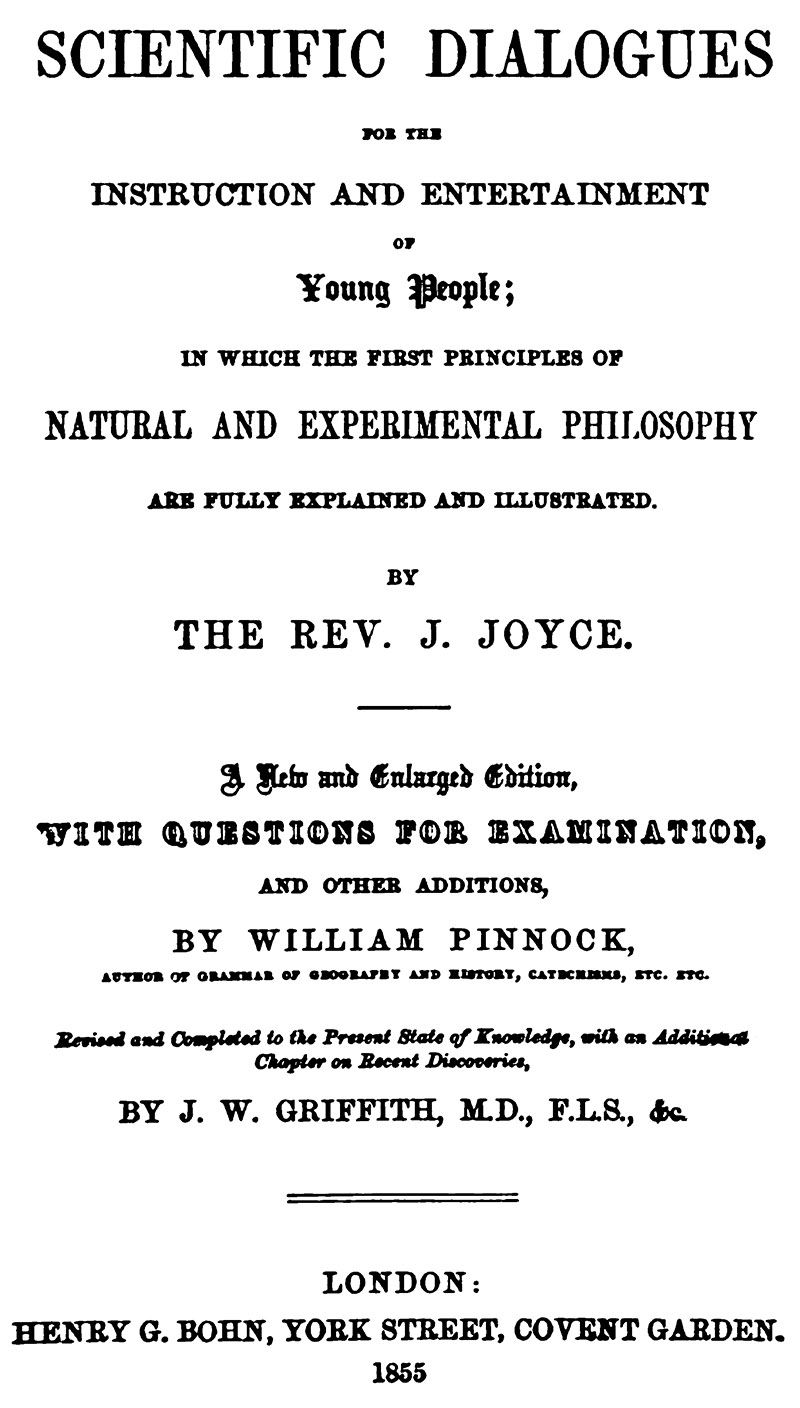
Figure 7.
Title page of the 1855 edition of "Scientific dialogues for the Instruction and Entertainment of Young People", "Revised and Completed to the Present State of Knowledge, with an Additional Chapter on Recent Discoveries", by John W. Griffith.
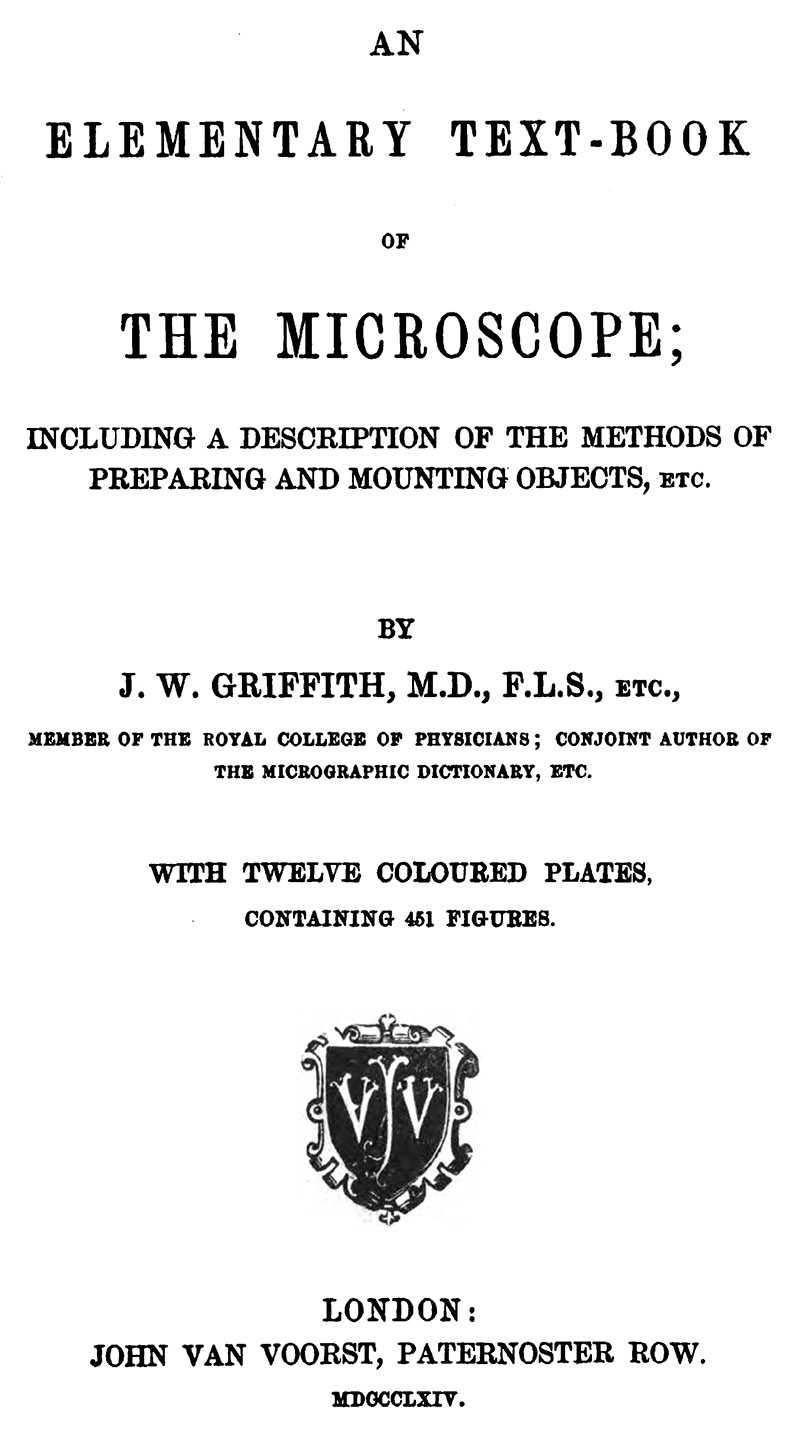
Figure 8.
Title page of "An Elementary Text-Book of the Microscope", 1864.
Resources
Beckmann, J, W. Francis, and J.W. Griffith (1846) A History of Inventions, Discoveries, and Origins, Fourth edition, H.G. Bohn, London
The Charities of London (1861) "Finsbury Dispensary, 16, Woodbridge Street, Clerkenwell, E.C., established 1780. The registered applicants annually relieved with advice and medicine gratis, is quoted as upwards of 20,000; but the report and cash statement are not published for last year. Treasurer, Richard Martineau, Esq. -Physicians, Drs. John Thomson and John W. Griffith. -Hon. Consulting Surgeons, George Macilwain and James Thomas Ware, Esqrs. -Surgeon, James Sharman, Esq. -Resident Medical Officer, Mr. Edmund Meek. -Hon. Secretary, Mr. Richard Moreland", Sampson Low, Son, and Co., London, page 41
England census and other records, accessed through ancestry.com
Griffith, John W. (1842) Critical examination of Dr. Stark's observations on the urine of pregnancy, The London and Edinburgh Monthly Journal of Medical Science, Vol. 2, pages 563-567
Griffith, John W. (1842) On the detection of albumen in urine, London Medical Gazette, page 112
Griffith, John W. (1843) On the different modes of preserving microscopic objects, Annals and Magazine of Natural History, Vol. 12, pages 113-117
Griffith, John W. (1843) On the microscope: means of remedying the defects of artificial light, Annals and Magazine of Natural History, Vol. 12, pages 481-482
Griffith, John W. (1843) A Practical Manual, Containing a Description of the General, Chemical and Microscopical Characters of the Blood, and Secretions of the Human Body, R. and J.E. Taylor, London
Griffith, John W. (1843) On the blood and fibre, London Medical Gazette, page 942
Griffith, John W. (1844) On iodine in the urine, The Chemical Gazette, Vol. 2, pages 5-6
Griffith, John W., Owen Rees, and Alfred Markwick (1848) Manuals on the Blood and Urine, Lea & Blanchard, Philadelphia
Griffith, John W. (1849) Remarks on the so-called cholera bodies, London Medical Gazette, pages 1034-1035
Griffith, John W. (1849) Remarks upon the crystals of oxalate of lime occurring in the urine, London Medical Gazette, page 1087
Griffith, John W. (1853) On Gallionella ferruginea (Ehrenb.), Annals and Magazine of Natural History, pages 438-439
Griffith, John W. (1854) On the relation of the angular aperture of the object-glasses of compound microscopes to their penetrating power and to oblique light, Proceedings of the Royal Society of London, pages 60-66
Griffith, John W. (1855) On the dots upon the valves of the Diatomaceae (read before the Royal Society), The London, Edinburgh, and Dublin Philosophical Magazine, Vol. 9, pages 383-384
Griffith, John W., and Arthur Henfrey (1856) The Micrographic Dictionary, J. Van Voorst, London
Griffith, John W., and Arthur Henfrey (1860) The Micrographic Dictionary, Second edition, J. Van Voorst, London
Griffith, John W. (1864) An Elementary Text-Book of the Microscope: Including a Description of the Methods of Preparing and Mounting Objects, etc., J. Van Voorst, London
Griffith, John W., Arthur Henfrey, Martin Duncan, M.J. Berkeley, and T. Rupert Jones (1875) The Micrographic Dictionary, Third edition, J. Van Voorst, London
Griffith, John W., Arthur Henfrey, M.J. Berkeley, and T. Rupert Jones (1883) The Micrographic Dictionary, Fourth edition, J. Van Voorst, London
Joyce, Jeremiah, William Pinnock, and John W. Griffith (1855) Scientific Dialogues for the Instruction and Entertainment of Young People; In Which the First Principles of Natural and Experimental Philosophy are Fully Explained and Illustrated, H.G. Bohn, London
List of the Fellows, Members, Extra-Licentiates and Licentiates of the Royal College of Physicians of London (1868) Members, "1845 John William Griffith, M.D. St. Andrew's, 6, Wrotham road, Camden New Town. N.W.", page 24
The London Medical Directory (1847) "Griffith, John William, 9, St. John's-square -- Physician; M.D. St. Andrews; Member Roy. Coll. Phys. Lond.; M.R.C.S. 1841; F.L.S.; Senior Physician to the Finsbury Dispensary; Editor of Beckmann's 'History of Inventions and Discoveries'; Author of the Jacksonian Prize Essay "On Urinary Diseases and their Treatment,” for the year 1844 ; Contributor of various communications and translations to the Ann Nat Hist, Phil Mag, Med Gaz, Edin Monthly Journal, and Chemical Gazette, page 66
Nature (1875) Review of The Micrographic Dictionary, Vol. 11, page 267
Probate of the will of Anne Griffith (1889) "The Will of Anne Griffith (Wife of John William Griffith) late of 13 Darlington-place in the City of Bath who died 14 January 1889 at 13 Darlington-place was proved at the Principal Registry by Joseph Deans Willis of Baptonin the Parish of Fisherton Delemere in the County of Wilts Gentleman the Brother the sole Executor. Personal Estate £348 8s 3d", accessed through ancestry.com
Probate of the will of John W. Griffith (1901) "Griffith John William of 57 Graces-road Camberwell Surrey M.D. died 3 March 1901 Probate London 11 April to Eliza Allen spinster Effects £1711 17s 10d", accessed through ancestry.com
Proceedings of the Linnean Society of London (1842) Members, "1842, Feb. 1, Griffith, John William, M.D. 9 St. John's-sq., Clerkenwell"
The Sanitary Record (1896) "Clerkenwell. Dr. John W. Griffith, upon retiring from the post of Medical Officer to the Vestry, has been granted a superannuation allowance of £133 6s. 8d", page 761
Science (1901) "Dr. John W. Griffith, for several years senior physician to the Finsbury Dispensary and medical officer of health to Clerkenwell, died recently at Camberwell in his 82d year. He was best known to naturalists as part author of Griffith & Henfrey's 'Micrographic Dictionary' ", Vol. 13, page 516







